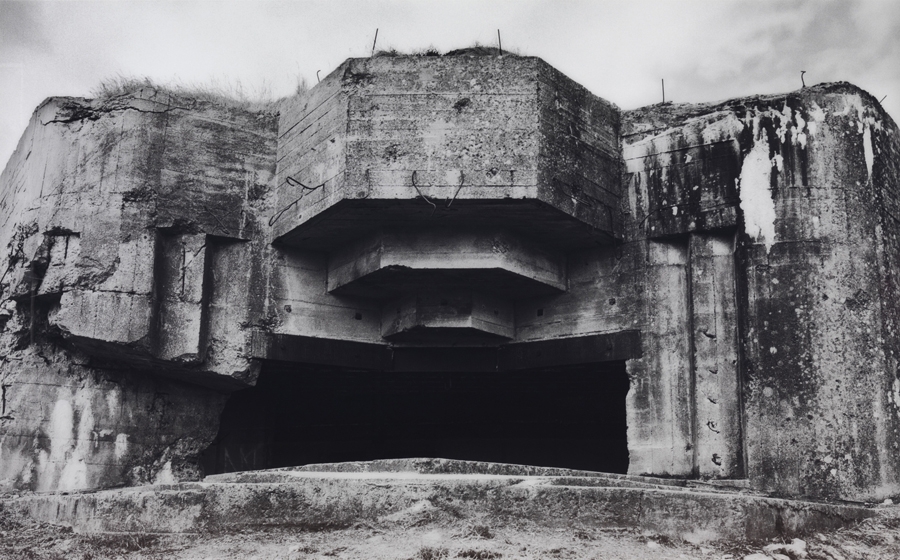Ruins are created suddenly or gradually – an eruption of magma or a growth of lichen. This is demonstrated in the first room of Ruin Lust, where John Martin’s The Destruction of Pompeii and Herculaneum (1822) meets Jane and Louise Wilson’s Azeville (2006), a huge monochrome photograph of a military bunker in Normandy. These kind of structures influenced modernist architecture, whose style struck J.G. Ballard as anticipating its own demise, perhaps because of the resemblance of the shuttered concrete to the layers of sedimentary rock that might, in some distant geological future, subsume it.
The curators make us wait for the inevitable. I counted ten dilapidated abbeys in the second room, their serial presentation underlining the eighteenth-century craze for picturesque decay in Europe. In Turner’s Tintern Abbey: The Crossing and Chancel, Looking Towards the East Window (1794), two sightseers are dwarfed by crumbling columns, reminding us that these artists didn’t just inaugurate a genre, they started a tourist industry. But ruins aren’t just retrospective, ie, decay ‘interpreted’; they can be premonitory too, as with Joseph Gandy’s drawing Bird’s Eye View of the Bank of England (1830). It was John Soane himself who instructed Gandy to depict parts of his under-construction building as a future ruin, the natty facade concealing an interior that resembles an archaeological dig.
You peer into the smutty blackness James Boswell’s tiny litographs, unable to discern looters from patrolmen, museums from bridges – war’s reduction of the particular to the general
Film offers the opportunity to show ruin in the making. The inclusion of Tacita Dean’s Kodak (2006) is a bonus. The work stakes everything on a tautology: the celluloid moving through the projector shows celluloid moving through the Kodak factory in Chalon-sur-Saône, scarcely visible in the gloom as it speeds through the rollers. Some see the results as a requiem to a dead medium, but it’s better than that: it’s a comprehensive embalming, the full Avalon treatment. Either side of this centrepiece, Ruin Lust features nice matches of method to subject matter. Laura Oldfield Ford’s ballpoint pen feels perfect for municipal Modernism in her drawing Ferrier Estate (2010): an expedient instrument for an expedient architecture, with no moralistic upbraiding of its ‘failed utopia’ or false celebration either. James Boswell’s tiny lithographs of the Blitz show London’s masonry turning against its citizens. You peer into their smutty blackness, unable to discern looters from patrolmen, museums from bridges – war’s reduction of the particular to the general.
Despite its British bias, Ruin Lust doesn’t stray into ‘edgelands’ territory. A precedent for psychogeography emerges, however, in Paul Nash, whose essay ‘Swanage or Seaside Surrealism’ (1936) uncovers a vernacular Surrealism in Dorset. The accompanying photographs – especially Steps in a Field near Swanage (c. 1935) – show the painter’s fixation with isolated anomalies. John Latham’s 1976 proposal (for the Artist Placement Group) to designate as art five West Lothian shale heaps is here too, setting an elegiac tone that is amplified in the last room.
Keith Coventry’s bronze casts of broken saplings bear plaques giving the time of their planting and destruction, hence: Burgess Park SE5, Planted 1983, Destroyed 1988 (1994); while artist collective Inventory’s Estate Map (1999), a peeling metal sign taken from the Marquess Road Estate in the London borough of Islington, serves as a canvas for a bilious rant. The words marker-penned across its surface stress the absence of such social housing projects from urban maps, and the consequent relegation of their thoroughfares to something ‘less’ than streets. It’s the perfect Russian ending to a terrific show, though Inventory’s contribution is best seen alongside founding member Adam Scrivener’s essay from the same year, ‘Open Yet Excluded’, which charts the transition of the Marquess Estate ‘from pseudo-rural idyll to prison camp’.
This article was first published in the May 2014 issue.
